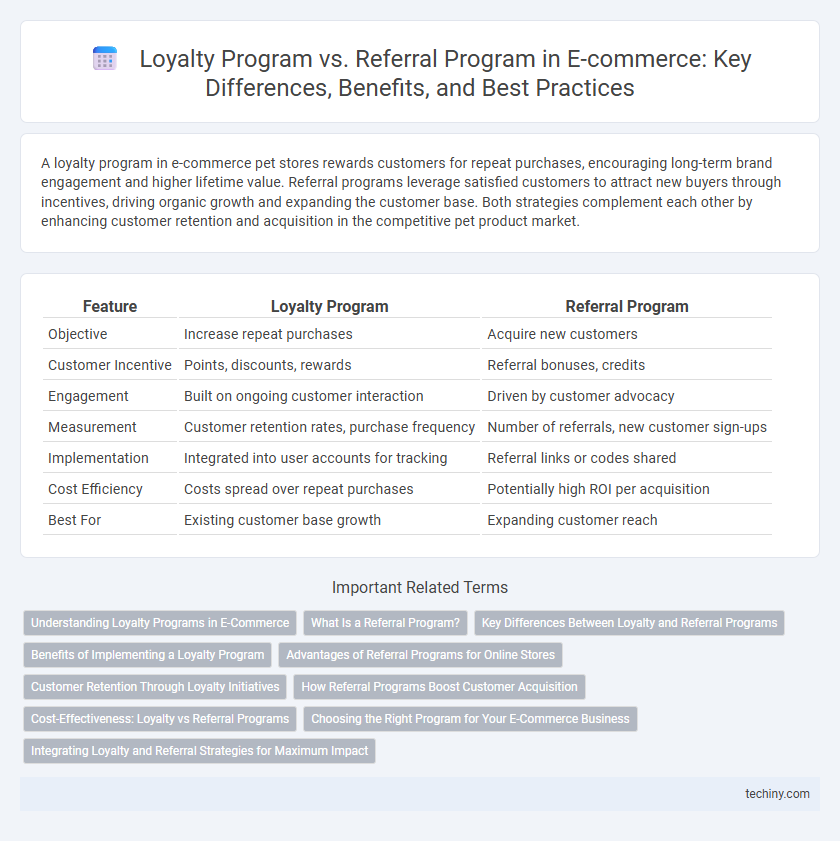A loyalty program in e-commerce pet stores rewards customers for repeat purchases, encouraging long-term brand engagement and higher lifetime value. Referral programs leverage satisfied customers to attract new buyers through incentives, driving organic growth and expanding the customer base. Both strategies complement each other by enhancing customer retention and acquisition in the competitive pet product market.
Table of Comparison
| Feature | Loyalty Program | Referral Program |
|---|---|---|
| Objective | Increase repeat purchases | Acquire new customers |
| Customer Incentive | Points, discounts, rewards | Referral bonuses, credits |
| Engagement | Built on ongoing customer interaction | Driven by customer advocacy |
| Measurement | Customer retention rates, purchase frequency | Number of referrals, new customer sign-ups |
| Implementation | Integrated into user accounts for tracking | Referral links or codes shared |
| Cost Efficiency | Costs spread over repeat purchases | Potentially high ROI per acquisition |
| Best For | Existing customer base growth | Expanding customer reach |
Understanding Loyalty Programs in E-Commerce
Loyalty programs in e-commerce drive repeat purchases by rewarding customers with points, discounts, or exclusive offers, increasing customer lifetime value and retention rates. These programs use data analytics to personalize rewards and enhance engagement, leading to higher average order values and reduced churn. Integrating loyalty programs with CRM systems helps e-commerce businesses track customer behavior and optimize marketing strategies for sustained growth.
What Is a Referral Program?
A referral program in e-commerce incentivizes existing customers to recommend products or services to new potential buyers by offering rewards such as discounts, store credits, or exclusive deals. This strategy leverages word-of-mouth marketing to increase customer acquisition cost-effectively while enhancing brand trust through personal endorsements. Referral programs typically track referrals via unique links or codes, providing measurable data on customer-driven growth and engagement.
Key Differences Between Loyalty and Referral Programs
Loyalty programs primarily reward customers for repeat purchases, enhancing retention through points, discounts, or exclusive offers, while referral programs incentivize existing customers to bring in new buyers by offering rewards for each successful referral. Loyalty programs focus on nurturing long-term customer relationships, whereas referral programs drive new customer acquisition by leveraging word-of-mouth marketing. The key difference lies in their strategic objectives: loyalty programs boost customer lifetime value, and referral programs expand the customer base.
Benefits of Implementing a Loyalty Program
Implementing a loyalty program in e-commerce drives repeat purchases by rewarding customers for their ongoing engagement, significantly increasing customer lifetime value and retention rates. Loyalty programs provide actionable data on consumer behavior, enabling personalized marketing strategies that enhance customer satisfaction and boost sales. Exclusive rewards and tier-based incentives foster brand allegiance, turning frequent buyers into brand advocates and reducing churn.
Advantages of Referral Programs for Online Stores
Referral programs for online stores drive authentic customer acquisition by leveraging existing customers' networks, resulting in higher trust and conversion rates. These programs reduce marketing costs compared to paid advertising while enhancing customer engagement and brand advocacy. Referral incentives also foster long-term loyalty by rewarding both referrers and new customers, creating a sustainable growth loop for e-commerce businesses.
Customer Retention Through Loyalty Initiatives
Loyalty programs drive customer retention by rewarding repeat purchases and fostering brand allegiance, using points, discounts, and exclusive offers to enhance customer lifetime value. Referral programs leverage satisfied customers to attract new buyers, expanding the customer base while simultaneously encouraging continued engagement through social incentives. Both initiatives improve retention metrics but loyalty programs more directly boost repeat purchase rates and sustained customer interactions.
How Referral Programs Boost Customer Acquisition
Referral programs significantly enhance customer acquisition by leveraging the trust and social networks of existing customers, resulting in higher conversion rates. These programs incentivize current users to share brand recommendations, increasing organic reach and attracting qualified leads at a lower cost than traditional marketing campaigns. Data shows referral-referred customers have a 37% higher retention rate, making referral programs a strategic tool for sustainable growth in e-commerce.
Cost-Effectiveness: Loyalty vs Referral Programs
Loyalty programs typically yield higher customer retention rates at a lower acquisition cost compared to referral programs, which incur expenses related to rewards for both referrer and referee. Referral programs often generate new customers more rapidly but require substantial incentives that can increase overall marketing costs. Analyzing cost-per-acquisition (CPA) metrics reveals loyalty programs generally offer a more cost-effective strategy for sustained revenue growth in e-commerce.
Choosing the Right Program for Your E-Commerce Business
Selecting the right program for your e-commerce business hinges on understanding customer behavior and long-term value. Loyalty programs boost repeat purchases by rewarding frequent buyers with points or discounts, enhancing customer retention and increasing average order value. Referral programs leverage existing customers to bring in new ones through incentives, driving customer acquisition and expanding your market reach efficiently.
Integrating Loyalty and Referral Strategies for Maximum Impact
Integrating loyalty and referral programs in e-commerce enhances customer retention and acquisition by combining rewards for repeat purchases with incentives for bringing new customers. This unified approach leverages data analytics to personalize offers, increase customer lifetime value, and improve overall engagement across multiple channels. Businesses that optimize both programs see higher conversion rates and sustainable growth through a synergized customer experience.
Loyalty Program vs Referral Program Infographic

 techiny.com
techiny.com